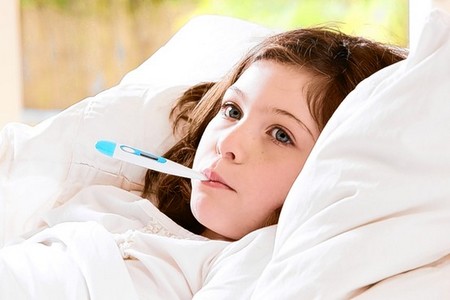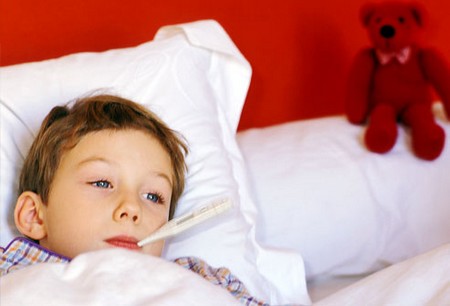A fever is common with an infectious illness and it’s important to know how to make a child comfortable. Not only is it unpleasant to be hot and sweaty, but it can also make a baby or young child dangerously dehydrated and overheated and make a febrile convulsion more likely.
Knowing if your child has a fever
Most parents know by their child’s flushed face and ears and dulled eyes if he has a fever. You can also get a very good idea by feeling how hot his forehead is, though this isn’t always reliable. A feverish child usually goes off his food, sleeps fitfully, perhaps has nightmares, is irritable, tends to cry, may have a headache or pain behind the eyes and feels generally achy.
If you have a thermometer you will know definitely whether your child has a high temperature and may decide to ask your doctor to come to your home rather than take the child to the surgery. Also, you’ll have an idea as to whether the child’s temperature is steady, falling or rising. If the child has a rising temperature, or if he is very hot already, it’s a good idea to cool him down before the doctor comes, to make him more comfortable and to reduce the risk of him having a convulsion. Occasionally, however, using a thermometer can be misleading, for with some illnesses the child can be very unwell, but may nonetheless have a low or normal temperature.
Taking your child’s temperature
There are two types of thermometer for home use: the standard glass clinical thermometer and the newer liquid crystal thermometers (fever strips), which are plastic strips with sections that change colour at different temperatures.
If you decide to buy a glass thermometer, choose a stubby-ended one that can be used in the mouth or under the arm. Don’t take his temperature if your child has had a hot bath within the last hour and remember that if he’s had a hot-water bottle with him, it might alter the temperature reading if it was near his cheek or armpit. Obviously a hot drink within the last half hour will affect the reading if you take his temperature by mouth. Whichever method you use, make him sit or lie down quietly for five minutes before you take his temperature.
Reading a glass thermometer
Hold the thermometer at eye-level with the degree markings facing you. You will see an arrow that indicates where ‘normal’ is. Roll the thermometer slightly backwards and forwards between your thumb and finger until the light catches the thick grey line of mercury. The number where the mercury stops indicates the temperature.
Using a glass thermometer
Hold the thermometer at the opposite end to the silver mercury bulb. Shake the mercury level down with sharp flicks of the wrist to well below the average normal temperature (36-37.5°C [97-99.5°F] measured in the mouth; approximately 0.5°C [1°F] lower if measured under the arm).
Depending on the age of your child, decide where you’re going to take his temperature. Don’t take it in the mouth of a baby or very young child because he might bite the thermometer, break the glass and swallow the poisonous mercury. The safest place to take it is in the armpit.
Sit your child on your lap and place the thermometer in his armpit, folding his arm to keep it in place. Hold your child still because you won’t get an accurate reading if you don’t and also because the thermometer might snap if he wriggles about.
Leave it there for three minutes at least and add approximately 0.5°C (1°F) to the reading to give an estimate of the child’s inner body temperature.
An older child can have his temperature taken by mouth. Put the thermometer, bulb end first, under his tongue and tell him to close his mouth gently without biting. He should breathe through his nose. If he has to breathe through his mouth because of a heavy cold, the reading will not be accurate, so it’s better to take the temperature under his arm or with a fever strip.
When you’ve finished, wash the thermometer with soap and cold water and put it away in its container.
Using a fever strip
Place the strip across his forehead, which must be dry. Take the reading after fifteen seconds. This gives an estimate of the body’s inner temperature. If your child has a temperature as high as 39.4°C (103°F) or if you are worried about him, you must speak to the doctor.
Cooling a child
You can make a feverish child comfortably cooler by removing his clothing and bedcovers, controlling the room temperature, giving cool drinks, giving junior paracetamol in the recommended dose, and by giving him a cool (but not cold) bath.
If he’s too unwell to have a bath, cool him by tepid sponging. This is a useful technique to know if your child has a temperature of more than 39.4°C (103°F). Undress him, lay him on his bed (preferably on a plastic or rubber sheet), get a bowl of warm water and sponge him all over with it. Don’t dry him because the evaporation of the moisture has a cooling effect. Leave a warm wet flannel on his neck and another two on his groin, and check his temperature every ten minutes until it comes down to 37.8°C (100°F).
Categories
Advertisements
Recent Articles
 How to Understand Bed Sizes – A Small Guide
How to Understand Bed Sizes – A Small Guide How to Select Some Must Have Kitchen Accessories
How to Select Some Must Have Kitchen Accessories Best Way to Change a Car Tire
Best Way to Change a Car Tire Best Way to Write an Affirmation
Best Way to Write an Affirmation Best Way to Take Charge of Your Financial Life
Best Way to Take Charge of Your Financial Life Best Way to Survive a Party When You Don’t Know Anyone
Best Way to Survive a Party When You Don’t Know Anyone Best Way to Stop Self Sabotaging Yourself
Best Way to Stop Self Sabotaging Yourself Best Way to Start Journal Writing
Best Way to Start Journal Writing Best Way to Speak with a Powerful Voice
Best Way to Speak with a Powerful Voice Best Way to Simplify Your Life
Best Way to Simplify Your Life Best Way to Respond to a Put-Down
Best Way to Respond to a Put-Down Best Way to Reduce Acne Breakouts
Best Way to Reduce Acne Breakouts Best Way to Recover from Dining Disasters
Best Way to Recover from Dining Disasters Best Way to Quit Your Job Gracefully
Best Way to Quit Your Job Gracefully Best Way to Make Your Own Website
Best Way to Make Your Own Website




Leave a Reply